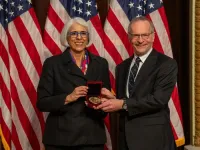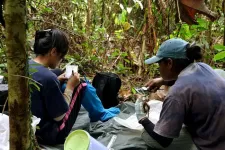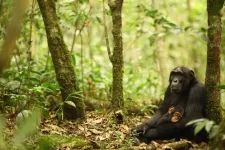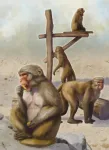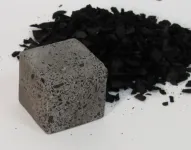(Press-News.org) UNIVERSITY PARK, Pa. — Richard Alley, Evan Pugh University Professor of Geosciences at Penn State, was awarded the National Medal of Science at a White House ceremony on Jan. 3.
Alley was one of 23 individuals and two organizations awarded the 2025 National Medals of Science and National Medals of Technology and Innovation, the nation’s highest honors for achievement and leadership in science and technology.
“Dr. Alley is deeply deserving of this most prestigious honor, and it is heartening to know that our nation sees in him what the Penn State community has known for decades,” said Penn State President Neeli Bendapudi. “Dr. Alley is the epitome of an exceptional scientist. His career studying our planet’s ice sheets has shaped Earth science and climate policy throughout the world. He exemplifies the very best of our University, inspiring others through his pursuit of knowledge and his commitment to advancing solutions for a sustainable future. This honor reflects the profound impact of his research on our world and future generations.”
Alley studies the planet’s largest and oldest ice sheets to help predict future changes in climate and sea level. He led a team that discovered Earth experienced abrupt changes in climate in the past — and likely will again. His meticulous study of two miles of ice cores from Greenland and Antarctica revealed key “switches” and “dials” in Earth’s climate that can lead to environmental changes with significant ecological and economic impacts.
“My piece of this story is small, but our community as a whole provides reliable, useful information that can help people, and I’m grateful for the opportunity to contribute to this important effort and to the National Medal of Science for highlighting it,” Alley said. “The discoveries we have brought home, together with an immense amount of information from other scientists and engineers, show clearly that if we effectively use our knowledge on climate and energy, we can build a larger economy with more jobs, improved health and national security, as well as a cleaner environment for all.”
The National Medal of Science was established by the U.S. Congress in 1959 and is administered by the U.S. National Science Foundation (NSF). The medal is the highest recognition the nation can bestow on scientists and engineers. A committee of experts is appointed by the president of the United States to evaluate the nominees for the award, which, according to an NSF statement, is given to “individuals deserving of special recognition by reason of their outstanding contributions to knowledge in the physical, biological, mathematical, engineering, or social and behavioral sciences, in service to the Nation.”
Alley joined the faculty of Penn State in 1988 after graduating from the University of Wisconsin in 1987. He said he views the award as a “testament” to decades of work with colleagues and students at Penn State, including the Penn State Ice and Climate group and more broadly in the University’s Earth and environmental and energy sciences.
“This honor is a richly deserved recognition of Richard’s lifelong work as both a scientist and public educator,” said Andrew Read, senior vice president for research at Penn State. “He has lifted the entire Penn State research enterprise through his enthusiasm and passion for work with global impact. I also must acknowledge his role as a mentor to generations of Penn State students, who come here to learn from leading scholars like Richard. His teaching is not limited to our community; he showed the world that the history of our planet is written in layers of ice, a history that will inform our future.”
For decades, Alley has been an enthusiastic science communicator. He has authored or coauthored over 300 peer-reviewed scientific papers, hosted the PBS special, “Earth: The Operators’ Manual” and wrote its companion book, authored a popular account of climate change and ice cores called “The Two-Mile Time Machine,” and regularly appears in national and international media outlets. In recent years, Alley served as one of the authors on the U.N. Intergovernmental Panel on Climate Change, whose members shared the 2007 Nobel Peace Prize.
Four other Penn State scientists have been awarded the Medal of Science. Stephen Benkovic, Atherton Professor and Eberly Chair in Chemistry, was awarded the medal in 2010 by President Barack Obama for his research contributions in the field of bioorganic chemistry, which have changed our understanding of how enzymes function and advanced the identification of targets and strategies for drug design.
Nina Fedoroff, emeritus professor of biology, was awarded the medal by President George W. Bush in 2007 for her work on plant molecular biology and being the first to clone and characterize maize transposons, segments of DNA that can change positions within the genome.
Calyampudi Rao, emeritus holder of the Eberly Family Chair in Statistics who died in 2023, was awarded the medal in 2002 by President George W. Bush for his contributions to the foundations of statistical theory and multivariate statistical methodology, and their applications, enriching the physical, biological, mathematical, economic and engineering sciences.
Erwin Müeller, Evan Pugh Research Professor of Physics who died in 1977, was posthumously awarded the medal by President Jimmy Carter in 1977 for his invention of the field-emission microscope, the field-ion microscope and the atom-probe microscope, which helped to resolve the atomic structures of solids and allowed him to “see” an atom for the first time.
“Those who earn these awards embody the promise of America by pushing the boundaries of what is possible,” according to a statement issued by the White House. “These trailblazers have harnessed the power of science and technology to tackle challenging problems and deliver innovative solutions for Americans and for communities around the world. Their accomplishments advance American leadership in science, technology, and innovation, and their work inspires the next generation of American leaders.”
END
Earth scientist awarded National Medal of Science, highest honor US bestows on scientists
Richard Alley, renowned geoscientist, is the fifth Penn Stater in history to receive the prestigious award
2025-01-09
ELSE PRESS RELEASES FROM THIS DATE:
Research Spotlight: Lipid nanoparticle therapy developed to stop tumor growth and restore tumor suppression
2025-01-09
Yang Zhang, PhD, and Jinjun Shi, PhD, both of the Center for Nanomedicine and Department of Anesthesiology, Perioperative and Pain Medicine at Brigham and Women’s Hospital, are co-senior authors of a paper published in ACS Nanoscience Au, “Lipid Nanoparticle Delivery of mRNA and siRNA for Concurrent Restoration of Tumor Suppressor and Inhibition of Tumorigenic Driver in Prostate Cancer.”
How would you summarize your study for a lay audience?
Most cancers occur when there is an imbalance of cellular growth and inhibition, causing cells to grow rapidly and form tumors in the body. For example, ...
Don’t write off logged tropical forests – converting to oil palm plantations has even wider effects on ecosystems
2025-01-09
A research team led by the University of Oxford has carried out the most comprehensive assessment to date of how logging and conversion to oil palm plantations affect tropical forest ecosystems. The results demonstrate that logging and conversion have significantly different and cumulative environmental impacts. The results have been published today (10 January) in Science.
Understanding how different aspects of tropical forests are affected by logging and conversion to oil palm plantations is important for identifying priority habitats for conservation and restoration. It can also help aid decisions on land use – for instance, whether a logged forest should be ...
Chimpanzees are genetically adapted to local habitats and infections such as malaria
2025-01-09
Chimpanzees bear genetic adaptations that help them thrive in their different forest and savannah habitats, some of which may protect against malaria, according to a study by an international team led by UCL researchers.
Chimpanzees are our closest living relatives, sharing over 98% of their DNA with humans, and the scientists say that their findings, published in Science, can not only teach us about our own evolutionary history, but also about the biology of malaria infection in humans.
Chimpanzees are endangered ...
Changes to building materials could store carbon dioxide for decades
2025-01-09
Replacing conventional building materials with materials modified to store carbon dioxide could move the planet closer to net-zero greenhouse gas emissions, according to a new study by Elisabeth Van Roijen and colleagues. The researchers calculate that full replacement of conventional building materials with these CO2-sequestering alternatives could store as much as 16.6 ± 2.8 gigatons of CO2 each year – an equivalent to about 50% of the anthropogenic CO2 emissions in 2021. Removing carbon dioxide from the atmosphere, along with decreasing emissions, is important for slowing ...
EPA finalized rule on greenhouse gas emissions by power plants could reduce emissions with limited costs
2025-01-09
In this Policy Forum, John Bistline and colleagues analyze the potential impacts of the U.S. Environmental Protection Agency’s finalized power plant rules regarding greenhouse gas emissions. Using nine models of the U.S. electric sector and energy systems, the researchers found that the rules would speed up the reduction of emissions in the power sector. Under the rules, the levels of carbon dioxide emitted by the sector would be 61%-81% below 2005 levels by 2040. Under current policies, emission levels would be 51% to 83% below 2005 levels by 2040, ...
Kangaroos kept a broad diet through late Pleistocene climate changes
2025-01-09
Samuel Arman and colleagues’ close examination of tooth microwear among living and extinct kangaroo species suggests that most of the species living in Australia during the Late Pleistocene had a broad, generalist diet rather than being specialized grazers. This broad diet likely allowed them to survive the glacial-interglacial cycles that drove fluctuations in vegetation on the continent. The findings add more evidence to the idea that human hunting, rather than failure to adapt to climate changes, ...
Sex-specific neural circuits underlie shifting social preferences for male or female interaction among mice
2025-01-09
Male and female mice both prefer social interaction with female mice under normal conditions, but both switch to preferring males when their survival is threatened, according to a new study by Anqi Wei and colleagues. These preferences are mediated by different neuronal circuitry in male and female mice related to dopaminergic neurons in the brain’s ventral tegmental area, the researchers found. The findings offer a clearer picture of the underlying biology of socio-sexual preferences. These preferences are essential for successful reproduction, ...
The basis of voluntary movements: A groundbreaking study in ‘Science’ reveals the brain mechanisms controlling natural actions
2025-01-09
Eight years of work. A collaboration between the Laboratory of Neuroethology of Non-Human Primates of the Department of Medicine and Surgery of the University of Parma, led by Luca Bonini, and a team from the Biorobotics Institute of the Sant'Anna School of Pisa, coordinated by Alberto Mazzoni, principal investigator at the Computational Neuroengineering Lab, with the contribution of Silvestro Micera, professor in Bioingeneering. Support from three projects funded by the European Research Council (ERC) and as many Italian national projects, including MNESYS and BRIEF. These are just some of the elements of a groundbreaking study published in ...
Storing carbon in buildings could help address climate change
2025-01-09
Construction materials such as concrete and plastic have the potential to lock away billions of tons of carbon dioxide, according to a new study by civil engineers and earth systems scientists at the University of California, Davis and Stanford University. The study, published Jan. 10 in Science, shows that combined with steps to decarbonize the economy, storing CO2 in buildings could help the world achieve goals for reducing greenhouse gas emissions.
“The potential is pretty large,” said Elisabeth Van ...
May the force not be with you: Cell migration doesn't only rely on generating force
2025-01-09
By Beth Miller
In mechanobiology, cells’ forces have been considered fundamental to their enhanced function, including fast migration. But a group of researchers in the McKelvey School of Engineering at Washington University in St. Louis has found that cells can generate and use lower force yet move faster than cells generating and using high forces, turning the age-old assumption of force on its head.
The laboratory of Amit Pathak, professor of mechanical engineering and materials science, found that groups of cells moved faster with lower force when adhered to soft surfaces with aligned collagen fibers. Cells have been thought to continually generate ...
LAST 30 PRESS RELEASES:
Making lighter work of calculating fluid and heat flow
Normalizing blood sugar can halve heart attack risk
Lowering blood sugar cuts heart attack risk in people with prediabetes
Study links genetic variants to risk of blinding eye disease in premature infants
Non-opioid ‘pain sponge’ therapy halts cartilage degeneration and relieves chronic pain
AI can pick up cultural values by mimicking how kids learn
China’s ecological redlines offer fast track to 30 x 30 global conservation goal
Invisible indoor threats: emerging household contaminants and their growing risks to human health
Adding antibody treatment to chemo boosts outcomes for children with rare cancer
Germline pathogenic variants among women without a history of breast cancer
Tanning beds triple melanoma risk, potentially causing broad DNA damage
Unique bond identified as key to viral infection speed
Indoor tanning makes youthful skin much older on a genetic level
Mouse model sheds new light on the causes and potential solutions to human GI problems linked to muscular dystrophy
The Journal of Nuclear Medicine ahead-of-print tip sheet: December 12, 2025
Smarter tools for peering into the microscopic world
Applications open for funding to conduct research in the Kinsey Institute archives
Global measure underestimates the severity of food insecurity
Child survivors of critical illness are missing out on timely follow up care
Risk-based vs annual breast cancer screening / the WISDOM randomized clinical trial
University of Toronto launches Electric Vehicle Innovation Ontario to accelerate advanced EV technologies and build Canada’s innovation advantage
Early relapse predicts poor outcomes in aggressive blood cancer
American College of Lifestyle Medicine applauds two CMS models aligned with lifestyle medicine practice and reimbursement
Clinical trial finds cannabis use not a barrier to quitting nicotine vaping
Supplemental nutrition assistance program policies and food insecurity
Switching immune cells to “night mode” could limit damage after a heart attack, study suggests
URI-based Global RIghts Project report spotlights continued troubling trends in worldwide inhumane treatment
Neutrophils are less aggressive at night, explaining why nighttime heart attacks cause less damage than daytime events
Menopausal hormone therapy may not pose breast cancer risk for women with BRCA mutations
Mobile health tool may improve quality of life for adolescent and young adult breast cancer survivors
[Press-News.org] Earth scientist awarded National Medal of Science, highest honor US bestows on scientistsRichard Alley, renowned geoscientist, is the fifth Penn Stater in history to receive the prestigious award
